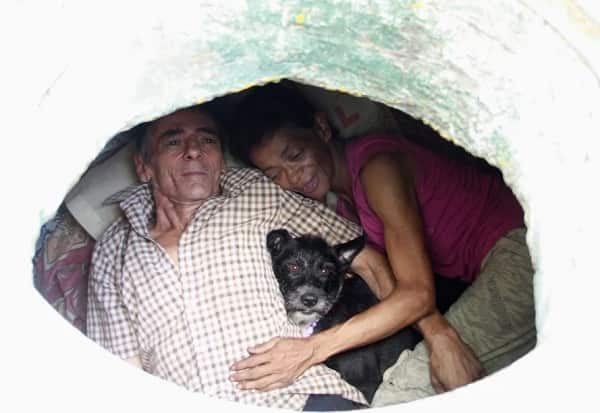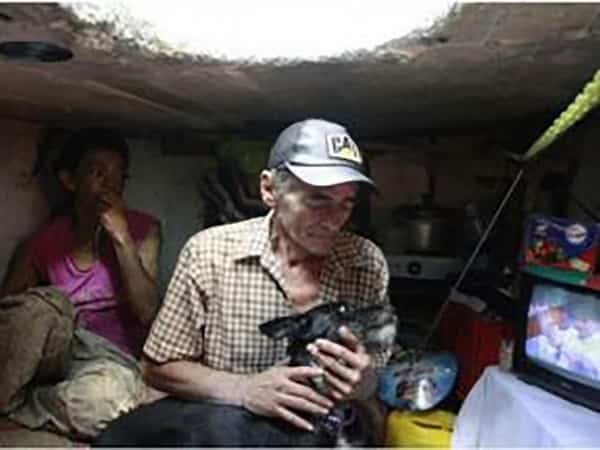A Couple’s 22-Year Journey of Love and Survival in the Sewers of Colombia

For over two decades, Miguel Restrepo and María García have called an unlikely place “home”—a cramped sewer beneath the streets of Colombia. Their story is one of hardship, resilience, and unwavering love. Once battling addiction and homelessness, this couple transformed a dark, damp tunnel into a space filled with warmth, hope, and even celebration.
Here’s how they turned despair into determination and found light in the shadows.
How It All Began: Love on the Streets
Miguel and María first crossed paths on the streets of Colombia, both struggling with addiction and survival. Life had been unkind—María had lost contact with her family years earlier, while Miguel left home after constant fights over his substance use. Homeless and alone, they relied on odd jobs or begging to eat. But when they met, something changed. María recalls, “We saw our own pain in each other. Slowly, we became each other’s reason to keep going.”
Their bond grew stronger, and they vowed to quit drugs together. “Love gave us courage,” Miguel says. “We didn’t want to lose each other to the streets.”
A Desperate Decision: Shelter in the Sewers
After years of sleeping in parks or abandoned buildings, the couple faced a crisis. Rising crime in their area made sleeping outdoors unsafe, and shelters were overcrowded. One rainy night, they stumbled upon a sewer entrance. “We were terrified,” María admits, “but it was dry and hidden.” What started as a temporary refuge became their home for the next 22 years.
Building a Life Underground
The sewer, though grim to outsiders, slowly became their sanctuary. They cleaned the space, covered damp walls with old blankets, and even set up a makeshift kitchen using discarded pots. Over time, they added “comforts”:
- Electricity: A stolen cable (later replaced by a donated solar panel) powers a small bulb.
- Water: They collect rainwater in buckets and filter it using cloth.
- Heat: A tiny wood stove keeps them warm during cold nights.
Surprisingly, the couple decorates their space for holidays. “At Christmas, we hang paper stars,” María smiles. “It reminds us that joy can exist anywhere.”

Their Loyal Companion: Blacky the Dog
Three years into their sewer life, a stray dog wandered into their tunnel. They named him Blacky, and he’s been their protector and family ever since. “He barks if strangers come near,” says Miguel. “He’s our guardian.”
Daily Struggles and Small Triumphs
Life underground is far from easy. Flooding during rains forces them to flee temporarily. Diseases like respiratory infections are common, and they rely on charity clinics for care. Yet, they’ve built routines:
- Mornings: Collect recyclables to sell.
- Afternoons: Cook meals (often rice and beans) on their stove.
- Evenings: Share stories or play with Blacky.
“We’ve learned to appreciate little things,” María says. “A hot meal or a quiet night feels like a victory.”
Why Stay? The Meaning of Home
Many ask why they don’t seek help. The answer is simple: this sewer symbolizes their triumph over addiction and despair. “Here, we saved each other,” Miguel explains. “Leaving would feel like abandoning our journey.”
The Harsh Reality of Homelessness in Colombia
Colombia has over 30,000 homeless individuals, many battling addiction or mental illness. Shelters are scarce, and societal stigma often leaves people like Miguel and María invisible. Their story highlights a urgent need for systemic change—and compassion.
Video: Couple Living In A Sewer For Last 22 Years
FAQs About Miguel and María’s Life
How do Miguel and María get electricity in the sewer?
They use a small solar panel donated by a local charity.
What do they eat daily?
Mostly rice, beans, and canned goods from kind strangers.
Have they tried to get government help?
Yes, but paperwork and lack of IDs made it impossible.
Do they have contact with family?
No—both families cut ties years ago due to addiction.
How do they stay safe from crime?
Blacky alerts them to danger, and they hide their entrance.
Have they ever gotten seriously ill?
María had pneumonia twice but recovered at a free clinic.
Why don’t they leave the sewer?
It’s their symbol of survival and love; leaving feels like losing their history.
Do they celebrate birthdays?
Yes! They save up for cake and sing to each other.
How do they bathe?
They use public restrooms or wet wipes.
What’s the hardest part of sewer life?
Isolation and the stigma of being homeless.
Has anyone offered them housing?
A neighbor once let them stay for a week, but they returned to the sewer.
How do they earn money?
By selling recyclables and occasional street performances.
What happens during heavy rains?
They stay with a friend or in a shelter until the sewer drains.
Are they happy?
“We’re content,” says Miguel. “We have each other and Blacky.”
